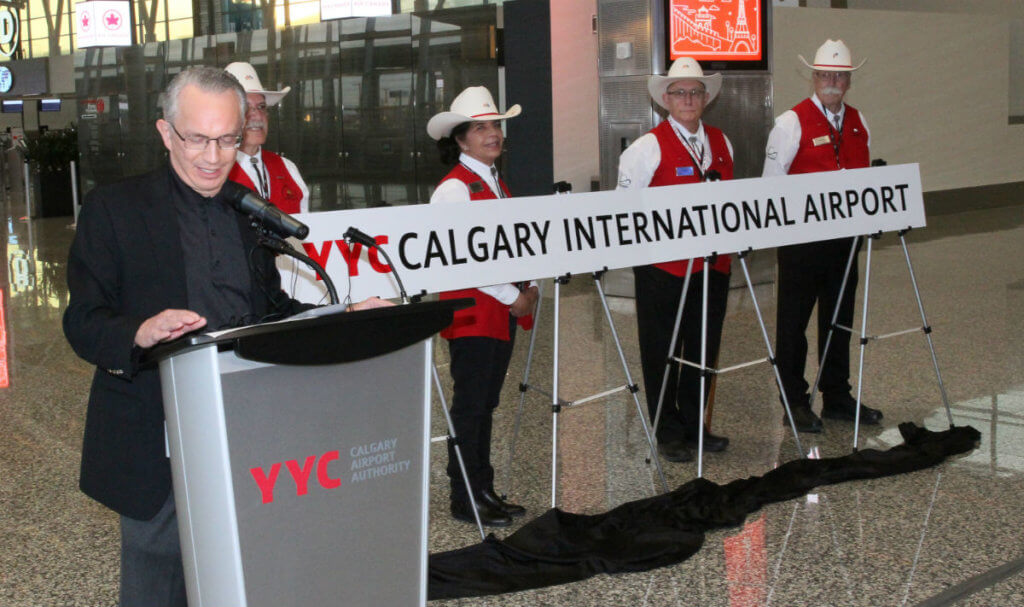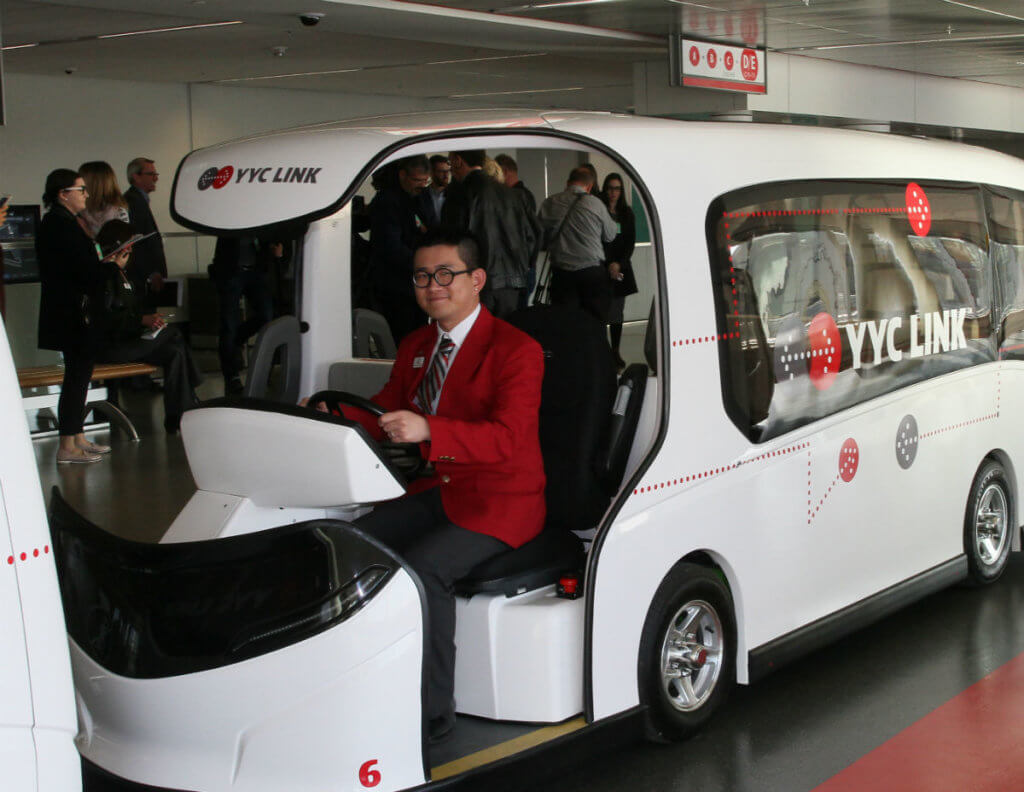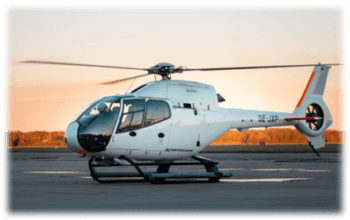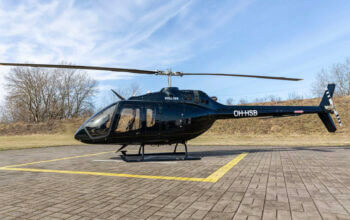Estimated reading time 8 minutes, 54 seconds.
It’s big, it’s posh, it has wall to wall cutting-edge technology and it even has a new name.
Moments before the media previewed the extension to the existing terminal on Oct. 6, Calgary Airport Authority (CAA) president and CEO Garth Atkinson announced the new name of the airport: YYC Calgary International Airport.

The Calgary airport was originally named in recognition of Calgary’s Fred McCall, a First World War fighter ace and aviation raconteur. For decades, what was then known as McCall Field slowly grew in size until the development of a new terminal that opened in 1977. Sometime in the 1980s, the McCall name disappeared and Calgary (CYYC) became known as Calgary International Airport.
In recent years, speculation circulated that CYYC would follow the suit of many Canadian airports and be named after a local politician. Instead, federal transport minister Marc Garneau officially named it YYC Calgary International Airport, thereby removing any connection to well-known Calgary politicians such as Ralph Klein or recently retired Prime Minister Stephan Harper, both former Conservative politicians.
The international terminal, at two million square feet (approx. 186,000 square metres) is twice the size of the existing domestic terminal. It encompasses 24 gates, all designed to be used for either U.S. or international destinations and can handle any aircraft size; 50 shops, both dining and merchandise related; two post-security departure halls and five Kid Zone areas, all unique and featuring different themes.
Linking the international terminal with the domestic terminal is a secure corridor, featuring 20 custom-designed YYC Link 10 passenger shuttles, moving sidewalks and walkways that allow passengers to remain inside security if they are connecting to other flights. Connections centres provide a means for inbound passengers to have their baggage rerouted to other flights without having to claim and rescreen them.
The marble floors, wood panelled walls and top end seating areas are supplemented by art from a number of Canadian and international artists.
The introduction of modern technology is perhaps the feature that will please most passengers and it is all about self-service to speed the passenger on their way. There are 238 self-service kiosks in the departures hall and customs clearance areas for outbound and inbound passengers, all having the ability to operate in multiple languages.
The baggage handling system is a high-speed system enabling each bag to ride in its own “tote.” These units have radio frequency identification (RFID) transmitters allowing the bag to be tracked during its travel throughout the 10 kilometres of track. Bags will arrive at their appropriate destination within 10 minutes of being loaded by the passenger in the departure hall. This system has been installed for over a year and has been extensively tested; it can handle 4,000 bags per hour and consumes 60 per cent less energy than a conventional conveyer belt system.

The YYC Link passenger shuttles are Canadian-designed and built vehicles and will travel from one end of the domestic terminal to the international terminal in five minutes, carrying up to 10 passengers and their carry-on luggage. They are also wheelchair accessible. Airside passengers can board a shuttle and depart at one of four station stops.
Outbound
On arrival at the huge departure hall, passengers see numerous kiosks, which will start their journey. Passengers can retrieve their reservation and print boarding passes and baggage tags, then place their checked luggage on one of 20 self-bag drop units and proceed directly to security.
Customer service agents are also available for those who have special needs or are not familiar with technology.
Access to the screening facility requires the passenger to swipe their boarding pass through a scanner, cutting out the need for additional inspection. The first of its kind carry-on baggage screening system is the main feature in the passenger screen area. It can be used simultaneously by four passengers at a time.
Four loading positions provide bins allowing a passenger to place items in one and it is immediately whisked down the 30-metre scanner and into the X-ray machine. As each bin is loaded, another is automatically provided so a business traveller with one bag can load his or her items and walk away towards the personal screener while someone with multiple bags is using another location and does not hold up the next person in line.
The contents of each item is inspected by staff in another part of the terminal so there is no hold up in the bins moving through the X-ray. If a bag requires a secondary inspection the examiner can select it to be shunted to the manual inspection area away from the main passenger flow.
Upon leaving the screening area those with U.S. destinations must swipe their boarding pass to gain entrance to the U.S. Customs pre-clearance area. There are 25 self-serve kiosks where passengers scan their passport, boarding pass and fill out their U.S. declaration online. They then proceed to the U.S. Customs and Border Protection agent for verification of identity with their inputted information and secondary questions.
On one side of the room are eight NEXUS/Global Entry kiosks (compared to the present four) for utilization of those passengers with the trusted passenger classification. Once complete, international passengers go directly to the international departures hall.

Both the U.S.-bound and international passengers have their own food court and duty-free shopping area in their departure hall. The biggest one is in the U.S.-bound area, with many seating food outlets, bars and shopping options.
Extensive passenger seating options are in the two food court areas with many seats equipped with charging stations. Everywhere throughout the terminal, large LCD screens give up-to-the minute information on flights. This information is a necessity as gate numbers are not printed on boarding passes.
A call-to-gate system has been designed to keep passengers in the central area until a given time prior to departure when flight and gate positions will be announced. All gates are no more than five minutes from this area and the intent is to minimize seating at the gates, keeping passengers close to all services until they board.
Arrivals
Passengers must walk or take elevators down to Canada Customs when departing an arriving aircraft. Inside the arrivals customs hall, passengers are separated into arriving Canadian citizens, visitors and NEXUS/Global entry. There are long rows of kiosks where passengers scan passports and customs declarations prior to proceeding to a Canada Border Services agent for identity verification and possible secondary questioning. From here, passengers proceed to large baggage carousels to claim their baggage or to the connections centre to continue on to other Canadian destinations.
The new terminal is designed to enhance passenger experience and provide a smooth flow between curbside and boarding. The CAA has hired 2,000 new employees, of which over 100 will act as curbside and customer care ambassadors along with the existing 100-plus White Hat volunteers to answer passenger questions and assist in their experience at the new facility.
The international terminal is set to open to the public on Oct. 31, 2016.









Having a new additional airport is always cool and it will boost tourism. Additionally, a very advanced and digital airport will definitely help the country.